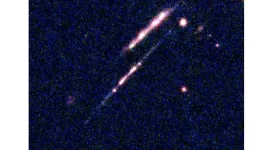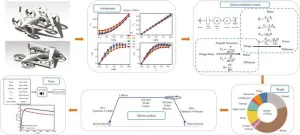(Press-News.org) The history of how stars and galaxies came to be and evolved into the present day remains among the most challenging astrophysical questions to solve yet, but new research brings us closer to understanding it.
In a new study by an international team led by Dr. Angela Adamo at Stockholm University, new insights about young galaxies during the Epoch of Reionization have been revealed. Observations with the James Webb Space Telescope (JWST) of the galaxy Cosmic Gems arc (SPT0615-JD) have confirmed that the light of the galaxy was emitted 460 million years after the big bang. What makes this galaxy unique is that it is magnified through an effect called gravitational lensing, which has not been observed in other galaxies formed during that age. The magnification of the Cosmic Gems arc has allowed the team to study the smaller structures inside an infant galaxy for the first time. The authors found that the Cosmic Gems arc harbors five young massive star clusters in which stars are formed. “The surprise and astonishment was incredible when we opened the JWST images for the first time” says Adamo.
The mystery of the early Universe
The Epoch of Reionization (EoR) is a crucial time during the evolution of the Universe, which occurred within the first billion years after the Big Bang. During this period, the Universe went through an important transition. In its early days it was filled with neutral Hydrogen gas, but this changed during the EoR. The matter of the Universe went from its neutral form to being fully ionized; the atoms were stripped from their electrons. The earliest galaxies of the Universe are believed to have driven this transformation.
In order to study the earliest galaxies one has to look far away in space. Light travels at a finite speed. By observing objects at far distances we can “look back in time” as we see the state of the object at the time when the light was emitted from it. However, it is difficult to observe small details of an object at large enough distances to study the early Universe. One method to observe finer details in a galaxy at a great distance is through the use of gravitational lensing. Gravitational lensing occurs when a celestial body of high mass curves the path of light around it due to its strong gravity. When the light emitted from a source passes through the gravitational lens it is distorted similar to the effect of a magnifying glass. In this way, astronomers can observe small details in objects far away.
Galaxies slowly build their stellar population through a process referred to as star formation. In local galaxies we see that a large fraction of stars form in star clusters. Star clusters are groups of stars held together by gravitational forces. Star clusters can have varying sizes, where some only contain a small amount of stars to others that can contain millions. Globular clusters are very old star clusters where stars have previously been formed, but not anymore. How and where the globular clusters were formed has been a long-standing mystery.
New insights into the formation of the first stars and galaxies
In a new study published in the scientific journal Nature, the team of astronomers present the discovery of star clusters in a galaxy whose light has passed through a gravitational lens on its way towards the Earth. “This achievement could only be possible thanks to JWST unmatched capabilities”, says Dr. Adélaïde Claeyssens of Stockholm University and co-author of the publication. The galaxy SPT0615-JD, also known as the Cosmic Gems Arc, is located in the distant Universe. The light that has reached the Earth in the present day was emitted from this galaxy only 460 million years after the Big Bang. By studying this object, the astronomers look back 97% of the cosmic time.
“Due to the gravitational lensing, the Cosmic Gems Arc could be resolved down to small enough scales to study the objects within it”, adds Claeyssens. The team used the instrument Near Infrared Camera (NIRCam) onboard the JWST for their observations. The NIRCam is an instrument built to take high-resolution images in the near-infrared part of the light spectrum, in which the earliest stars and galaxies can be detected. Using the high resolution of the JWST NIRCam, the resulting observations showed a chain of bright dots mirrored from one side to the other. It was discovered that these dots were five young massive star clusters.
Through analysis of the light spectra emitted by the galaxy, it could be determined that the stellar clusters are gravitationally bound and have a three-times larger stellar density than typical young star clusters in the local Universe. It was also found that the clusters were formed recently, within 50 million years. They are very massive, although much smaller than globular clusters. “It was incredible to see the JWST images of the Cosmic Gems arc and realize that we were looking at star clusters in such a young galaxy. We observe globular clusters around local galaxies, but we don’t know when and where they formed. The Cosmic Gems arc observations have opened a unique window for us into the works of infant galaxies as well as showing us where globular clusters formed” says Adamo. “These clusters will have enough time to relax and become globular clusters, due to them being formed at such a young age of the Universe”, she adds.
Understanding the early Universe
Through studies of star clusters in young galaxies born shortly after the Big Bang, further understanding of how and where globular clusters are formed can be achieved. Since young galaxies are believed to drive the reionization during the EoR, it is crucial to study them in depth in order to gain knowledge about the early Universe. Using the discoveries made by the authors of this study, more information is added to our understanding about how the stars in the earliest galaxies were born, and where and how globular clusters are formed.
Looking onwards
In the future, the group is planning to build a larger sample of similar galaxies. “We have one galaxy so far, but we need many more if we want to create demographics of the cluster populations forming in the earliest galaxies.” says Adamo. The team also has an approved program for the next cycle of JWST observations, where they will study the Cosmic Gems Arc galaxy and the recently discovered star clusters in further detail. “Spectroscopic observations will allow us to spatially map the star formation rate and ionizing photon production efficiency along the galaxy” adds Dr. Larry Bradley, principal investigator of the JWST program and the second author of this article.
This article
The article “Bound star clusters observed in a lensed galaxy 460 Myr after the Big Bang” is published in the scientific journal Nature. Dr. Angela Adamo, Associate Professor of the Galaxy group at the Department of Astronomy at Stockholm University, is the lead author of the article. Dr. Adélaïde Claeyssens is a Postdoctoral researcher at the Department of Astronomy at Stockholm University, and Erik Zackrisson, Associate Professor at the Department of Physics and Astronomy at Uppsala University, are co-authors of the study.
More information
ESA press release: https://esawebb.org/news/weic2418/
END
Star clusters observed within a galaxy in the early Universe for the first time
2024-06-24
ELSE PRESS RELEASES FROM THIS DATE:
How much oxygen do very premature babies need after birth?
2024-06-24
Giving very premature babies high concentrations of oxygen soon after birth may reduce the risk of death by 50 percent, compared to lower levels of oxygen says new research led by University of Sydney researchers.
When premature babies are born, they sometimes need help breathing because their lungs haven’t finished developing. To help babies during this process, doctors may give them extra oxygen through a breathing mask or breathing tube.
The study, published in JAMA Pediatrics, examined clinical trial data and outcomes of ...
Trial offers hope for cheaper, more tolerable, ketamine treatment
2024-06-24
For those suffering from treatment-resistant depression, the anaesthetic drug ketamine offers hope, but it has side effects and can be costly to access – a University of Otago-led clinical trial may change that.
Working in collaboration with New Zealand’s Douglas Pharmaceuticals, researchers have conducted a trial of ketamine in an extended-release tablet form.
The study, published in prestigious international journal Nature Medicine, involved 168 adults for whom regular anti-depressant therapy ...
Fertility treatments could get boost from stem cells
2024-06-24
An unexpectedly versatile and regenerative stem cell in early embryos may be key to creating new effective fertility treatments, suggests a new study in mice from the University of Copenhagen.
It probably will not surprise anyone that pregnancy is a very complicated process. First, a sperm cell must find its way and fertilize an egg in the fallopian tube, after which the egg begins to divide. After about five days, the egg becomes a blastocyst, which eventually develops into a fetus.
But for more and more people, fertility is becoming increasingly harder to achieve due to various factors ...
Ketamine slow-release tablet reduces symptoms of severe depression: Clinical trial
2024-06-24
A new tablet form of ketamine has shown promise in treating severe depression, offering a potential alternative to existing clinic-based treatments that can be expensive and lacking in convenience for some patients.
Unlike the injectable and nasal spray alternatives that require clinicians to monitor patients for two hours while side effects subside, the slow-release tablet form can be taken safely at home without medical supervision and with negligible side effects.
Led by Professor Paul Glue of University of Otago, researchers from UNSW Sydney and the affiliated Black Dog Institute (BDI) collaborated with colleagues from ...
The future takes flight: Autonomous eVTOLs transforming air mobility
2024-06-24
In recent years, a new era of transportation innovation has unfolded with the introduction of autonomous electric vertical take-off and landing (eVTOL) aircrafts. These advanced air mobility (AAM) systems are poised to revolutionize urban and regional transportation by offering efficient, sustainable, and rapid transit solutions, potentially transforming daily commutes and cargo deliveries alike.
eVTOL technology, which enables aircrafts to ascend, hover, and land vertically, has become a focus for both academic research and commercial ventures due to its numerous advantages ...
One bad apple spoils the barrel: New study uncovers multiple molecular subgroups in liver cancer with most aggressive driving clinical outcomes
2024-06-24
Singapore, 24 June 2024 – A study led by clinician-scientists and scientists from the National Cancer Centre Singapore (NCCS) and A*STAR’s Genome Institute of Singapore (GIS) and funded by the National Research Foundation Singapore (NRF) has discovered unexpected molecular heterogeneity even within the same liver tumours. More than 40% of HCC harbours more than one molecular subtype within the same tumour and in these, the clinical outcomes for the patients are best predicted by the most aggressive subtype. This phenomenon, termed the “bad apple effect”, has significant implications on the understanding of liver cancer and suggests that a more holistic sampling ...
Rising health care prices are driving unemployment and job losses
2024-06-24
New Haven, Conn. — Rising health care prices in the U.S. are leading employers outside the health care sector to reduce their payroll and decrease their number of employees, according to a new study co-authored by Yale economist Zack Cooper.
The study, published June 24 as a working paper by the National Bureau of Economic Research (NBER), found that when health care prices increased, non-health care employers responded by reducing their payroll and cutting the jobs of middle-class workers. For the average county, a 1% increase in health ...
NUTRITION 2024 press materials available now
2024-06-24
Press materials are now available for NUTRITION 2024, the annual flagship meeting of the American Society for Nutrition (ASN). Top nutrition scientists and practitioners from around the world will gather to share the latest research findings on food and nutrition during the meeting, held in Chicago from June 29–July 2.
Register for a press pass to attend NUTRITION 2024 in person or to access embargoed press materials before the meeting. Explore the meeting schedule, poster presentations, poster theater flash sessions and oral presentations to see all the exciting research ...
Study Shows Stricter Alcohol Policies Are Associated with Reduction in Homicides
2024-06-24
Ann Arbor, June 24, 2024 – Alcohol consumption is involved in a large proportion of homicides and suicides each year in the United States, but there has been limited evidence on how policies targeting alcohol use influence violence. A statistical analysis in the American Journal of Preventive Medicine, published by Elsevier, indicates that more restrictive alcohol policy environments are associated with a reduction in specific states’ homicide rates.
Lead investigator James P. Murphy, PhD, RAND Corporation, Santa Monica, CA, says, "Previous studies have found a significant relationship between some state-level ...
Kennesaw State University researcher to analyze electromagnetic waves with help of grant
2024-06-24
The stereotype of mathematics and mathematicians involves a solitary pursuit of knowledge, but Eric Stachura knows better.
The Kennesaw State University assistant professor of mathematics works on quantitative analysis of electromagnetic waves and keeps a collaborative research practice with colleagues near and far. That partnership has led to a three-year grant worth $223,206 from the Army Research Office, a director of the U.S. Army Combat Capabilities Development Command Army Research Laboratory.
“It is a very collaborative subject, ...



